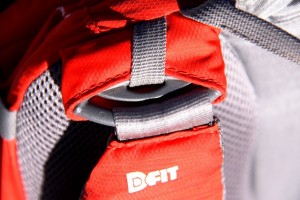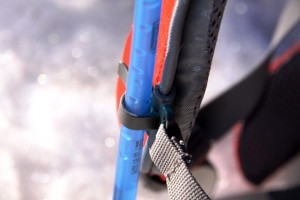
By Rick Shandley
For 2012, the men’s Camelbak Alpine Explorer day pack has a few upgrades, and continues to be a strong choice for a day pack that supports a full day of trail adventure. The Alpine Explorer offers a total of 1648 cubic inches of capacity, including the three-liter hydration reservoir. That’s about 30-liters of storage capacity for all day trail romping.
Alpine Explorer is a top-loading pack with three primary cargo pockets, a dedicated hydration bladder compartment, side-mounted mesh cargo pockets, and mount points for trekking poles and ice-axe. A small compartment on top, between the hydration-bladder compartment and the first primary cargo hold, is designated as a Media pocket for your MP3, GPS unit, or sunglasses. However, this small pocket would be great for housing a pack rain cover as well, and it is what several high-end multi-day pack manufacturers use it for.
Weighing a little more than two pounds sans water and gear, the Alpine Explorer appears to be constructed. Workmanship is apparent with tight, accurate, stitch-work shaping the 70D Diamond Clarus and 420D nylon fabric into a sturdy pack that we found to be comfortable to wear all day.

Two new color options are Dark Navy/Orion Blue and Fiery Red/Gargoyle. Our test pack is the Fiery Red/Gargoyle combination Alpine Explorer color. Gargoyle is merely as shade of gray. We like this color. This blazing fingernail red and gray Alpine Explorer pack would be easy for a search and rescue team member to see the pack poking out of a snow slide. And it’s one color your hiking friends can’t miss when they wonder how far up the trail you are above timberline.
The nylon pack fabric is coated with Deluge Water Resistant (DWR) and Polyurethane (PU) that is intended to resist water from a moderate rain or snowfall. Well, nothing is waterproof, but this water-resistant coating is an asset is you are visited by inclement weather on your hikes. The pack zippers are not water-resistant, neither is the back panel, insides of the shoulder straps, or the web material of the side pockets. No worries, though, this is a day-pack for hikers, not an assault pack.
In addition to the bulk inherent with three-liters of water on board, the Alpine Explorer offers plenty of storage for your wind parka, topographic map, headlamp, light down jacket, first-aid kit, gloves, emergency shelter, extra water, and food enough to support two people. The Camelbak product specs don’t give a pack load rating, but we found 15 to 25 pounds to be a decent range of weight carrying capacity. Unless you are a hard-core ultra-light trail Spartan, we would recommend this pack be used simply for day hikes, and it accomplishes that purpose well.

Camelbak’s Dynamic Suspension system uses a different upper harness strap connection system on the Alpine Explorer that may prove to enhance the long-term life of this pack. Where the shoulder straps connect to the main body of the pack at the shoulder area, robust independent composite/nylon material connection points – same material as the load carrying, quick-release buckles – fastens the top of the shoulder harnesses to the pack. This harness-buckle is housed in a fabric sleeve of the same nylon fabric the pack is made of to prevent friction wear.
At the bottom, the shoulder straps are sewn into the hip belt via the nylon strap in a traditional manner. Where we see a potential innovation here is that any twisting or tearing force that could be applied to the top of the shoulder harness – in the arc of the pack’s life – is theoretically eliminated because that tearing force is applied to the heavy-duty nylon connection point; and that hefty piece of plastic is not likely to break under normal day-hike conditions. And if it were to fail, then Camelbak’s lifetime product guarantee would be your fix-it solution. We’d like to see this specific technology applied to larger capacity, multi-day packs because that is a high-stress area of any pack.
Both sides of the sternum-strap can slide up or down the inward sides of the shoulder harnesses to accommodate your torso and comfort preference. The nylon hardware that supports the sternum-strap uses a clip mechanism to slide on fabric-covered piping that functions as a rail for the strap system to slide on. How well this system works in the long run is unknown, but it is innovative nonetheless. This feature demonstrates some thoughtful design and shows that the product design team at Camelbak is gaining expertise in pack design to compliment their hydration systems.

A sternum strap is always welcome, even with a smaller day-pack as the Alpine Explorer is. Keeping the pack, with any amount of weight in it, close to the body on the trail is important to keep the pack in position and not allowed to flail about with every step. Needless to say, a loose pack will rob you of energy more than you realize. That’s, arguably, because your body is constantly and subconsciously reacting to a shifting load.
And the water-tube clip is always welcome. It serves as both a clip to hold the Big Bite mouthpiece and as a contact point for the sternum strap to slide on the shoulder harness. The hydration reservoir water tube threads through a dedicated opening in the top-center of the Alpine Explorer pack to accommodate either left- or right-handed hikers. If you are left-handed, the water tube must cross over to the right side of your chest to hook-up with the tube clip. That’s ok, it’s not a significant detraction.
Possibly because the Alpine Explorer is a quick-load, ready to go compact gear hauler, the hip belt is removable. The hip belt is attached with a robust gauge Velcro fastening system. We like this feature because the Alpine Explorer is as much a commuter pack (overhead bin on a jet flight, back seat, saddle horn, etc.) as a trail pack. You can tailor this pack for specific types of on-trail or non-trail use. Sometimes you don’t need that hip belt to catch on anything. For example, we use chair-lifts when time is short, and they are available to access the high-country. And if you’ve ever had the hip-belt buckle catch on the chair lift as you are jumping out of the chair, you will value this little design detail.

Mesh webbing is used on the Air Director back panel and interior of the shoulder straps. When you are burning calories, regardless of the outside temperature, you are going to perspire… possibly even glow. The ventilation design of the Alpine Explorer works fine in this writer’s view. The mesh allows air to circulate and escape as well as any of the myriad of pack suspension systems available. You are still going to sweat if you are putting out any kind of energy, and this Air Director system manages air flow while offering good padding very well.
Behind the Air Director back panel is the composite (plastic) frame sheet. The frame sheet provides enough rigidity and load-bearing support to compliment the support/cushion of the back panel and the cushion-effect of the water reservoir.
Forward of the frame sheet is the dedicated hydration bladder compartment indicated with a blue-anodize section of aluminum tubing on the pull-tab of the zipper. This layered design, including the full three-liter Antidote water bladder, adds up to a more than adequate padding system that adds to comfort even as the water in the Antidote reservoir is depleted during the day. And it’s probably only with the smaller pack design that you might benefit from this sandwich effect that provides a pillow for your spine.
The outer-most pocket is nicely expandable, and serves bulkier items well. Camelbak calls it a quick stash overflow feature. That’s a great way to describe it. Even though a light-weight down jacket or sweater stuffs nicely into a small sack when you’re packing for the hike, it’s much less compact when you’ve been wearing it and now you just want it off your body. Or you start out hiking in the early morning, when that down-filled garment is nice. But after the sun comes out and you are starting to warm up, it’s cool to be able to stop on the trail, take it off, and plow it into a large catch-all pocket. Yep, you just cinch it down, load back up, and continue with your hike without worrying your new down-filled jacket falling out and becoming some other hiker’s find of the day.
Several of the day hikes the Alpine Explorer was tested on were hikes up Mt. Baldy in the Angeles National Forest of California. A couple hikes where taken on spider trails that connect to the Pacific Crest Trail from the region around Big Bear, CA. They were all alpine hikes above 7,000 feet elevation on sometimes fairly upwardly challenging trails and moderate physical exertion. So, if the Alpine Explorer were to prove an uncomfortable pack, even for its rather compact stature, it would have been revealed on these hikes.
Note: We use certain trails, the above two areas for example, as a constant test-ground that become familiar enough to this writer to distinguish between a product that is good for the duration of the day, and a product that is not. This goes for boots, packs, and outerwear especially. No complaints on comfort with the Alpine Explorer or the 2012 Camelbak Vantage 35 pack we’ll be sharing with you next.
100-ounce Antidote Reservoir

Camelbak’s new three-liter Antidote Reservoir is a good thing as far as we’re concerned. Two-liters of water are not enough sometimes. Having that extra liter of water on board is ultimately reassuring when your next water source may or may not be where you think it is on a long hike or multi-day back pack trip.
Water is vital, and it adds to the weight of your load, but you cannot be without it. Before the Antidote came along, carrying two, two-liter, Camelbak reservoirs plus water bottles was my best option. In arid regions of the U.S. and around the world, water is your lifeline to staying healthy. With the availability of the three-liter Antidote Reservoir, it is a nice buffer even if you don’t need to drink all of it on a day hike, as you will on an overnighter or multi-day hike.
The enhanced fill-port and quick-seal reservoir cap are added value to a stable original design. The improvement with the fill port is a new mechanism built into the fill-port assembly that hold the body of the water reservoir away from the fill port structure to air out the empty water bladder after use. This is important to let air into the bladder and hold it open so algae and bacteria cannot grow. And the quick-seal reservoir cap now requires much less twisting force to open and close. That’s a big difference from the previous generation fill cap lid (which provided an excellent seal) that took strong, monkey-like, fingers to open.

Another upgrade is the Quick Link tube attachment/detachment at the bottom of the reservoir, which makes it easy to clean or change out to a new one if needed. Changing out the previous tube design at the bottom of a Camelbak water reservoir was much less convenient. This upgrade, along with the reliable PureFlow water tube and Big Bite valve add up to a pretty decent value for a pack and hydration system that can serve you well on many day hikes.
Final Thought
We recommend the Camelbak Alpine Explorer pack for your consideration if your hiking plans include day-long treks. Those of you who really spend time outdoors will naturally own several pack sizes for various excursions. And this pack can fit right into the line-up like different surfboards for different wave conditions. Yeah baby. Alpine Explorer works where you need to have additional clothing layers, maps, headlamp, gloves, compass, misc. gear, food, and enough water to get you to your goal and back to the car on the same day. This pack is also a great choice for both dad and mom to have in order to carry enough water, snacks and support gear for children who may not be ready to carry their own weight just yet.
Updates:
- Color choice: Dark Nave/Orion Blue or Fiery Red/Gargoyle
- Double gear loops top and bottom
- Dual Hypalon (gray material) attachment points for increase load stability
Details
- Includes the new 100 oz (3 L) Antidote™ Reservoir
- HydroGuard: HydroGuard is a compound embedded into the reservoir material to control bacteria growth and odor.
- Alpine Explorer pack capacity: 1648 cu in (30 total liters)
- Back panel: Air Director
- Harness system: Dynamic Suspension with Slider Sternum Strap
- Hip belt: removable 1.5 in / 38 mm-thick nylon stability strap
- Pack weight: 2.2 lbs (1 kg)
- Fabric Specs: 70D Diamond Clarus & 420D Nylon with DWR + 1000mm PU coating
- Torso Length: 19 in (48 cm)
- Price: $115.00 U.S.












